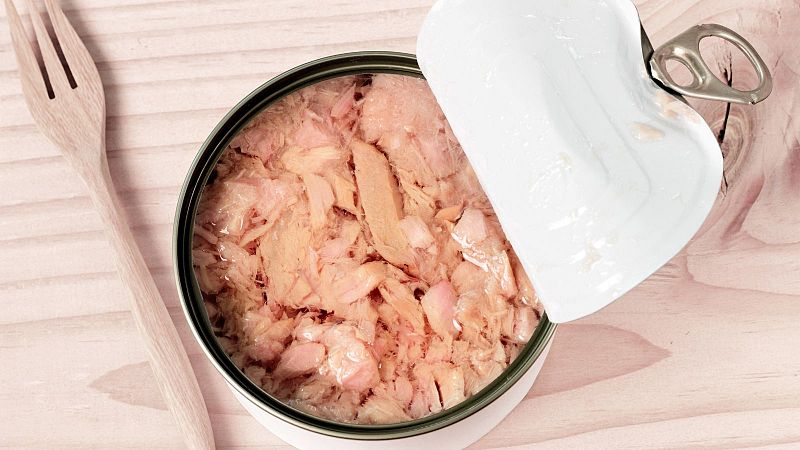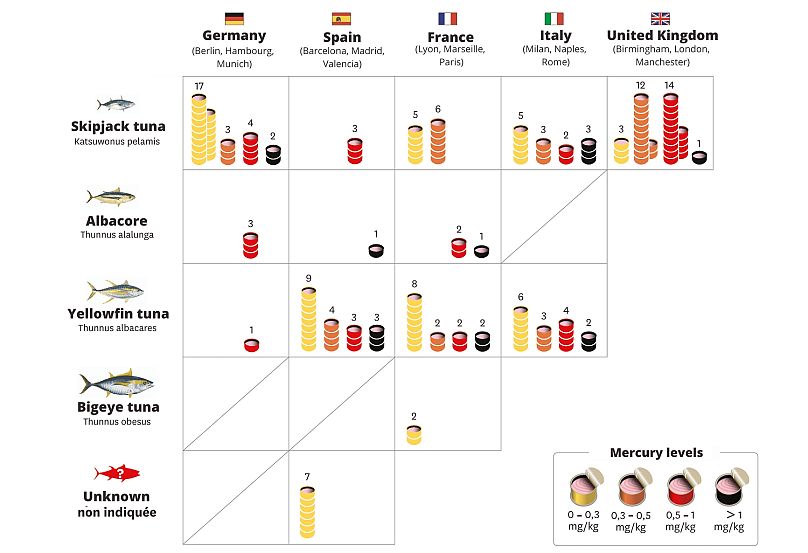High levels of mercury found in tinned tuna posing a 'colossal risk to public health' in Europe

Canned tuna in Europe has a high mercury concentration, exceeding the limit for other fish, according to a new report from the Paris-based NGO Bloom, which focuses on preserving the marine environment, and consumer rights organisation Foodwatch.
The NGOs analysed nearly 150 cans of tuna from five European countries: Germany, the United Kingdom, Spain, France, and Italy.
They found that all of the products contained mercury and 57 per cent exceeded the limit of 0.3 parts per million (ppm) that applies to other fish.
"What we end up with on our dinner plates is a colossal risk to public health that’s not considered seriously," Karine Jacquemart, CEO of Foodwatch France, told reporters.
The average European consumes over 2.8 kilogrammes of tuna per year, mostly canned. However, the canning process means that mercury concentration is doubled or tripled compared to the fresh product, according to Bloom.
Currently, the European standard sets the maximum mercury level at 1 ppm.
"We won't give up until we have a more protective European standard," Jacquemart said.
Meanwhile, the European Food Safety Authority (EFSA) set in 2012 the tolerable weekly intake (TWI) at 1.3 microgrammes of methylmercury per kilogramme of body weight - by comparison, the TWI in the US is 0.7, the NGOs said.
"If we apply the maximum threshold set out in European regulations, anyone weighing more than 79 kg is at risk after consuming one portion. So what's the point of these standards?" said Bloom’s Julie Guterman, who led the 18-month investigation.
The European Commission said in a statement provided to Euronews Health that the "maximum levels for mercury in food are established on the basis of the data we have on the actual, real-life occurrence of mercury in food".
"We do this by monitoring products that are placed on the market, taking into account the principle of ‘As low as reasonably achievable’ when producers use good practices," the Commission added.
The NGOs, meanwhile, claimed the heavy influence of tuna industry lobbies set the norm during the 1980s and 1990s.
What are the effects on health?
Methylmercury - the most common mercury form when it comes to food - is classified as “possibly carcinogenic to humans,” meaning it could have the potential to cause cancer.
Pregnant women and children are particularly vulnerable to high levels of methylmercury, according to the World Health Organization (WHO).
"Mercury is definitely a neurotoxin. It is toxic to the nervous tissue and in particular, it is toxic for the formation and development of the brain that happens in foetal life and in early childhood," Dr Philippe Grandjean, a professor in environmental medicine at the University of Southern Denmark said in a pre-recorded video shown at a press conference about the report.
Exposure of the foetus to methylmercury can lead to issues with cognition, memory, attention, language, fine motor skills, and spatial vision.
"We eat small doses for a very long time," Guterman said, with these doses piling up through time in a process called bioaccumulation.
This process explains why tuna is especially susceptible to being contaminated by mercury.
As tuna - and other predators or longer-living species like sharks or swordfish - are higher up the food chain, they eat smaller fish and accumulate more mercury over time.
Mercury is naturally present in ecosystems through volcanic eruptions and forest fires. However, human activities account for two-thirds of mercury sources due to the combustion of coal and fossil fuels, waste incineration plants, and more.
When it interacts with bacteria, such as those present in the ocean, the mercury becomes methylmercury, a toxic and bioaccumulative compound.
Future steps
Bloom and Foodwatch launched a campaign calling for stricter regulations such as reducing the current threshold of 1 ppm to 0.3 ppm, the one applied to other fish.
They also launched an international petition to ten of the largest retailers on the European market: Carrefour, Intermarché and Leclerc in France; Carrefour, Mercadona and Lidl in Spain; Conad, Coop and Esselunga in Italy; and Edeka, Rewe and Aldi in Germany, to remove products above the current threshold from their shelves and to inform consumers about potential health risks.
The Commission said that it "continually seeks out the latest scientific evidence to ensure our food safety rules are robust and up to date".
They said that there was no margin to further reduce the current maximum level below 1 ppm "without drastically disturbing food supply".
"It is important to note that there are different specific maximum levels for different fish species, because, as explained above, the maximum levels are established on the basis of their occurrence data," the Commission said.
"Indeed, when consuming high amounts of the most polluted fish with the highest maximum levels, the tolerable weekly intake can be exceeded".


